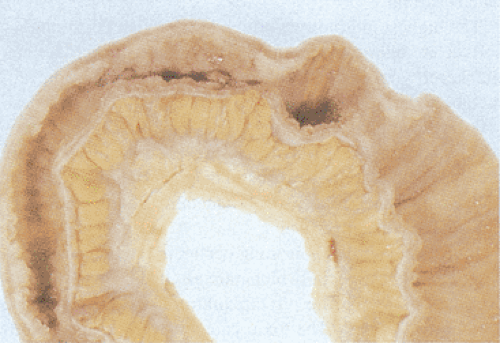Radiation Injury
The small intestine is more sensitive to radiation injury than is the large intestine. The degree of radiation damage reflects many factors (Table 6.11) (286). Patients who receive radiation often have acute but temporary diarrhea, nausea, vomiting, and abdominal cramps. These symptoms usually subside within weeks, due to rapid mucosal regeneration. A small percentage of patients experience a chronic deteriorating disease course, referred to as severe late radiation enteropathy. It is characterized by diarrhea, pain, malabsorption, small bowel obstruction, acute or chronic GI bleeding, intestinal perforation, and pseudo-obstruction. The intestinal pseudo-obstruction develops secondary to neuromuscular damage, vascular obliteration, and intestinal wall fibrosis (286).
TABLE 6.11 Factors that Enhance Radiation Injury | |
|---|---|
|
The severity of the acute radiation enteritis determines the severity of subsequent chronic disease. The outcome is mediated by mucosal and vascular damage as well as by host defenses to intraluminal antigens and pathogens. The damage is usually most severe in those parts of the small intestine that are fixed because this part of the gut receives a constant maximal radiation dose. Therefore, the duodenum, proximal jejunum, and terminal ileum are most likely to show maximum damage.
Patients with acute ischemic damage have an intestinal mucosa that appears reddened and inflamed, with edema and fibrinous peritonitis. The serosa acquires a matte-white appearance as serosal adhesions develop. Eventually the bowel appears markedly thickened, fibrotic, and indurated with stricture formation (Fig. 6.127). The bowel proximal to the strictures distends. The abnormal bowel merges imperceptibly with the noninjured bowel, making it difficult to identify the exact junction of the injured and uninjured bowel.
Acute radiation effects are predominantly mucosal in nature and range from mild epithelial degeneration to massive intestinal necrosis and ulceration. Endothelial apoptosis is the primary lesion initiating the bowel damage. Vascular damage ranges from isolated endothelial cell injury to complete capillary and venule obliteration. Capillary endothelium swells and the vessels become telangiectatic. Increases in vascular permeability immediately following radiation lead to edema and fibrin deposition in the interstitial spaces and blood vessel walls. The vascular damage leads to epithelial stem cell dysfunction (287).
Stay updated, free articles. Join our Telegram channel

Full access? Get Clinical Tree









